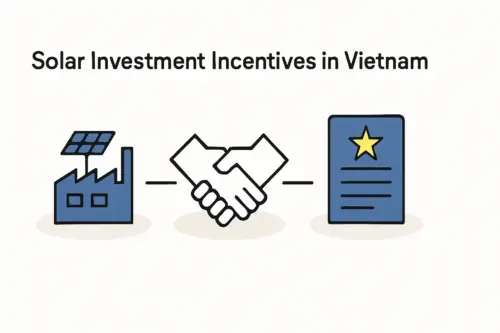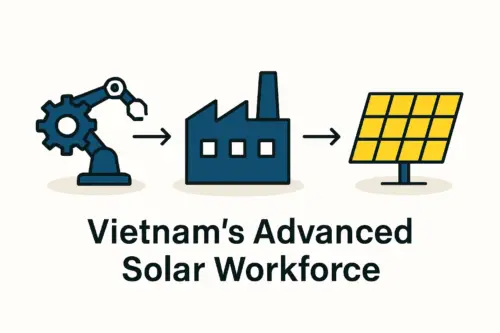Importing Solar Manufacturing Equipment into Vietnam: A Practical Guide to Customs and Tariffs
Vietnam has rapidly emerged as a global manufacturing powerhouse, making it an attractive destination for entrepreneurs looking to establish a solar module production facility.
While the country’s strategic position and favorable industrial policies present a significant opportunity, there’s a crucial first step: navigating Vietnamese customs. Before a single solar panel can be assembled, the sophisticated machinery required for production must complete a complex journey—a logistical and regulatory challenge many investors underestimate.
This guide provides a foundational understanding of the customs procedures, tariffs, and documentation needed to import solar manufacturing equipment into Vietnam. Proper preparation is more than an administrative task; it’s a critical component of risk management, essential for keeping a new venture on schedule and within budget. A comprehensive approach to these initial stages is a hallmark of planning a successful solar manufacturing business.
Understanding Vietnam’s Strategic Role and Import Landscape
Vietnam’s ascent as a key player in the global solar supply chain is no accident. It is the result of strategic government initiatives and a robust industrial base, making the country a prime candidate for new manufacturing operations. The equipment involved—such as stringers, laminators, and cell testers—is high-value, specialized technology that falls under intense scrutiny during the import process.
The success of a project hinges on the seamless transition of this machinery from port to factory floor. Any delays or unexpected costs at this stage can have a cascading effect on the entire project timeline.

Navigating Tariffs and Import Duties: The Financial Landscape
The financial implications of importing equipment are significant. The total cost is shaped by a combination of import duties, taxes, and benefits from international trade agreements. A clear understanding of these factors is essential for accurate financial forecasting.
The Importance of Harmonized System (HS) Codes
Every product imported into Vietnam must be classified under a specific Harmonized System (HS) code. This multi-digit code determines the applicable tariffs and regulations—think of it as a universal language for customs officials worldwide.
Assigning the correct HS code to each piece of solar manufacturing equipment is the most critical step in the import process. An incorrect code can lead to:
- Incorrect Duty Payments: This can result in either overpayment or underpayment, the latter of which brings penalties and legal complications.
- Significant Delays: Customs officials will hold shipments with incorrect classifications until the issue is resolved, disrupting project timelines.
- Missed Opportunities for Tax Reduction: Certain HS codes may be eligible for preferential treatment or exemptions.
The technical specifications of your machinery directly influence its classification, so accuracy is paramount when selecting the right manufacturing equipment.
Ready to make big Profits?
The solar Industry is Booming
WE HELP NEWCOMERS to the solar industry start their own solar module production line. Customers can make BIG PROFITS by selling modules and finding investors, without wasting money and time on things they don't need!
Leveraging Free Trade Agreements (FTAs)
Vietnam is a signatory to numerous Free Trade Agreements (FTAs) that can significantly reduce or even eliminate import duties. For investors importing solar manufacturing equipment, the most relevant agreements include:
- EU-Vietnam Free Trade Agreement (EVFTA): Offers substantial tariff reductions for machinery sourced from European Union countries. This is a major advantage for projects utilizing German-engineered equipment, based on J.v.G. Technology GmbH’s experience.
- Comprehensive and Progressive Agreement for Trans-Pacific Partnership (CPTPP): Provides benefits for equipment imported from member countries like Canada, Japan, and Australia.
- ASEAN-China Free Trade Area (ACFTA): Crucial for projects sourcing machinery from China, a major supplier of solar production equipment.
To benefit from these FTAs, the shipment must be accompanied by a valid Certificate of Origin (C/O) that proves the equipment was manufactured in a member country.
Calculating Potential Costs: Tariffs and VAT
The primary costs to anticipate are the import tariff and Value Added Tax (VAT).
- Import Tariffs: The rate depends on the HS code and the applicability of an FTA. Without an FTA, the Most Favored Nation (MFN) tariff rate applies. With a valid C/O, a much lower preferential rate is achievable.
- Value Added Tax (VAT): This tax is typically applied to the total value of the imported goods plus the import duty, making it a significant cost that must be factored into the project’s budget.
The Customs Clearance Process: A Step-by-Step Overview
While the customs process is detailed, it follows a sequence of core steps. Diligence and accurate documentation are the keys to a smooth clearance.

-
Pre-Arrival Preparation and Documentation: Before the equipment arrives at a Vietnamese port, you must prepare a complete set of documents. This typically includes the Commercial Invoice, Bill of Lading (or Airway Bill), Packing List, Certificate of Origin (if claiming FTA benefits), and detailed technical specifications for each machine.
-
Customs Declaration: The importer or their designated broker submits an electronic customs declaration through Vietnam’s official system (VNACCS/VCIS). All information must precisely match the supporting documents.
-
Inspection and Valuation: The customs authority classifies shipments into one of three channels:
- Green Channel: The declaration is accepted, and goods are released with minimal inspection.
- Yellow Channel: Documents are reviewed for accuracy before release.
- Red Channel: Both documents and the physical goods are inspected. High-value machinery often undergoes this level of scrutiny.
- Duty Payment and Release: Once the declaration is approved and any inspection is complete, the importer pays all applicable duties and taxes. The goods are released from customs control only after payment has been confirmed.
This entire sequence, from supplier to factory floor, requires meticulous coordination.

Common Challenges and How to Mitigate Them
Even with careful planning, investors can encounter challenges. Awareness is the first step toward mitigation.
- Documentation Errors: A minor discrepancy between the invoice and packing list, or an incorrect HS code, is the most frequent cause of delays and can halt the entire process. Mitigation: Implement a multi-stage review process for all documentation before submission.
- Customs Valuation Disputes: Vietnamese customs may challenge the declared value of the equipment if they believe it is too low. Mitigation: Maintain transparent and detailed records, including proof of payment, to substantiate the declared value.
- Logistical Delays: Port congestion and inland transportation can create bottlenecks. Mitigation: Work with an experienced logistics partner who has a strong network within Vietnam and can anticipate such issues.
- Regulatory Changes: Customs regulations and tariff schedules can change. Mitigation: Engage a local customs broker or consultant who stays current on the evolving regulatory landscape.
For complex projects like a turnkey solar production line, having an experienced partner manage these logistics isn’t a luxury—it’s a necessity to protect the project timeline and budget.
Frequently Asked Questions (FAQ)
Q1: How long does the customs clearance process typically take in Vietnam?
A: With all documents in perfect order, clearance can take 3–5 business days. However, if there are discrepancies, inspections, or valuation disputes, the process can extend to several weeks.
Q2: Do I need a local customs broker to import equipment?
A: While not legally mandatory for all entities, it is highly recommended. A licensed local broker understands the nuances of the Vietnamese system, has established relationships, and can navigate the bureaucracy far more efficiently than an outside party.
Q3: Are there any import duty exemptions for green technology like solar manufacturing equipment?
A: Vietnam offers investment incentives for certain high-tech or environmentally friendly projects, which may include exemptions or reductions on import duties. However, securing these incentives requires a separate application and approval process with the relevant government authorities, and applicants must meet specific conditions.
Q4: What is the most critical document for reducing import tariffs?
A: The Certificate of Origin (C/O) is the most critical document. Without a valid C/O that conforms to the requirements of a specific Free Trade Agreement, you cannot claim preferential tariff rates and will be subject to the higher standard MFN tariff.
Planning Your Next Steps
Successfully importing solar manufacturing equipment into Vietnam is a procedural exercise demanding precision and foresight. It is a foundational step in the broader journey of establishing a factory. Understanding these logistical requirements early in the planning phase is crucial to protecting your investment and setting the stage for operational success.
For entrepreneurs mapping out their entry into the solar industry, a structured understanding of every project phase is essential. E-courses from pvknowhow.com are designed to build this comprehensive knowledge base, guiding investors from initial concept to a fully operational facility.






